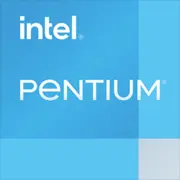Intel Pentium G4600

Intel Pentium G4600: Budget-Prozessor für grundlegende Aufgaben im Jahr 2025
Aktualisiert: April 2025
Einführung
Selbst fast 8 Jahre nach seinem Release (2017) bleibt der Intel Pentium G4600 eine beliebte Wahl für Budget-PCs. Seine Hauptvorteile sind der niedrige Preis (ca. 60-80 USD für ein neues Exemplar), Energieeffizienz und die Unterstützung moderner Technologien. Allerdings wirft seine Relevanz im Jahr 2025 Fragen auf. Lassen Sie uns klären, für wen dieses Modell von Interesse sein könnte und wer besser nach Alternativen suchen sollte.
1. Hauptmerkmale
Architektur und Fertigungsprozess
Der Pentium G4600 basiert auf der Mikroarchitektur Kaby Lake (7. Generation Intel) mit einem Fertigungsprozess von 14 nm. Dies ist die letzte Generation vor dem Wechsel von Intel zu 10 nm (Cannon Lake).
- Kerne und Threads: 2 Kerne / 4 Threads dank Hyper-Threading.
- Taktfrequenz: Basis — 3,6 GHz, Turbo-Modus ist nicht vorhanden.
- Cache: L3 — 3 MB (minimales Volumen für die Arbeit mit einfachen Anwendungen).
- TDP: 51 W — geeignet für kompakte Systeme.
Leistung
- Geekbench 6: Single-Core — 736, Multi-Core — 1530. Zum Vergleich: Der moderne Budgetprozessor Intel Celeron G6900 (2023) erreicht ~1100/2100.
- Reale Aufgaben:
- 4K-Video-Wiedergabe (mit Hardware-Decodierung über Intel HD Graphics 630).
- Arbeiten mit Büroanwendungen (Excel, Browser mit 10+ Tabs).
- Leichte Spiele (CS:GO, Dota 2 mit niedrigen Einstellungen — bis zu 60 FPS bei einer diskreten Grafikkarte der GTX 1650-Klasse).
Kernmerkmale
- Unterstützung für DDR4-2400 — relevant für Budget-Bauten.
- Integrierte Grafik HD Graphics 630 — ausreichend für die Anzeige von Bildern und anspruchslosen Aufgaben.
- Technologien: Intel Virtualization, AES-NI, jedoch keine Unterstützung für AVX2 und PCIe 4.0.
2. Kompatible Mainboards
Sockel und Chipsätze
- Sockel: LGA 1151 (Version v2, nicht kompatibel mit Mainboards der 8.-9. Generation!).
- Chipsätze:
- H110: Budget-Option (kein USB 3.1 Gen2, maximal 2 RAM-Steckplätze). Beispiel: ASUS H110M-K (50-60 USD).
- B250/H270: Optimale Wahl (4 RAM-Steckplätze, M.2 für NVMe). Beispiel: Gigabyte B250M-DS3H (70-80 USD).
- Z270: Für Enthusiasten (Übertaktung des Speichers, mehr Ports), aber überdimensioniert für Pentium.
Auswahlmerkmale
- Stellen Sie sicher, dass das BIOS des Mainboards auf eine Version aktualisiert ist, die Kaby Lake unterstützt (im Jahr 2025 haben die meisten neuen Platinen bereits die aktuelle Firmware).
- Um Kosten zu sparen, können Sie ein gebrauchtes Mainboard kaufen, aber neue Modelle sind immer noch verfügbar (zum Beispiel ASRock H270M Pro4 — 75 USD).
3. Unterstützung für den Speicher
- Typ: Nur DDR4 mit Frequenzen bis zu 2400 MHz (Übertaktung wird nicht unterstützt).
- Betriebsmodi: Dual-Channel — verwenden Sie 2 Module zur Leistungssteigerung (zum Beispiel 2x8 GB statt 1x16 GB).
- Maximales Volumen: 64 GB (aber für ein Büro-PC sind 8-16 GB ausreichend).
Beispielkonfiguration:
- Kingston Fury Beast DDR4-2400 8GB x2 (40 USD für das Set).
4. Empfehlungen für Netzteile
Bei einem TDP von 51 W reicht sogar ein bescheidenes Netzteil mit 300-400 W aus, aber berücksichtigen Sie andere Komponenten:
- Ohne dedizierte Grafikkarte: EVGA 400 N1 (400 W, 35 USD).
- Mit Grafikkarte (z. B. GTX 1650): Corsair CX450 (450 W, 55 USD) — Spielraum für zukünftige Upgrades.
Tipp: Sparen Sie nicht am Netzteil! Günstige Modelle (wie Apevia) können unter Last instabil arbeiten.
5. Vor- und Nachteile
Vorteile
- Preis: Einer der erschwinglichsten Prozessoren mit Hyper-Threading.
- Energieeffizienz: Geeignet für Mini-PCs und Systeme mit passiver Kühlung.
- Kompatibilität: Funktioniert mit Windows 10/11 und Linux.
Nachteile
- 2 Kerne: Multitasking ist eingeschränkt (Streaming + Spielen = Ruckler).
- Veraltete Architektur: Wird selbst von Budget-AMD Ryzen 3 5300G (4 Kerne / 8 Threads) übertroffen.
- Kein PCIe 4.0 und AVX2: Nicht geeignet für moderne Arbeitslasten (Rendering, maschinelles Lernen).
6. Nutzungsszenarien
Büro und Multimedia
- Arbeiten mit Dokumenten, Videokonferenzen, Netflix in 4K (mit DRM-Unterstützung).
- Beispiel: Büro-PC auf Basis G4600 + 8 GB RAM + SSD 256 GB — ideal für Buchhaltung.
Spiele
- Ohne Grafikkarte: Minecraft, League of Legends (30-40 FPS bei niedrigen Einstellungen).
- Mit Grafikkarte: GTA V, Fortnite (60 FPS bei GTX 1650).
Wichtig: Im Jahr 2025 könnten selbst Indie-Spiele wie Hades II mehr Kerne benötigen.
Heimserver
- Dank des niedrigen TDP geeignet für NAS oder Medienserver (Plex, Home Assistant).
7. Vergleich mit Wettbewerbern
AMD Athlon 3000G (2023)
- Preis: 55 USD.
- Vorteile: 2 Kerne / 4 Threads, Vega 3 Grafik (stärker als HD 630), Unterstützung für PCIe 3.0.
- Nachteile: Kein AVX.
Intel Celeron G6900 (2023)
- Preis: 75 USD.
- Vorteile: 2 Kerne / 2 Threads, aber höhere IPC (Einzel-Thread-Leistung +30%).
Fazit: Der Pentium G4600 ist nur bei Kauf gebrauchter Komponenten oder in kompletten OEM-Systemen vorteilhaft.
8. Praktische Tipps für den Aufbau
- Kühler: Der Standardkühler ist ausreichend, aber für leisen Betrieb ersetzen Sie ihn durch den Arctic Alpine 12 (15 USD).
- Speicher: SSD ist Pflicht (Crucial BX500 240 GB — 25 USD).
- Upgrade: Wenn Sie eine Grafikkarte installieren möchten, wählen Sie ein Mainboard mit PCIe x16 3.0.
Beispielaufbau für 250 USD:
- Prozessor: G4600 (70 USD).
- Mainboard: ASUS H110M-K (60 USD).
- Speicher: 8 GB DDR4-2400 (25 USD).
- Speicher: SSD 240 GB (25 USD).
- Netzteil: EVGA 400W (35 USD).
- Gehäuse: Deepcool MATREXX 30 (35 USD).
9. Fazit: Wer sollte den Pentium G4600 in Betracht ziehen?
Dieser Prozessor ist nur in drei Fällen von Interesse:
1. Bau eines Ultra-Budget-PCs für das Büro oder Studium.
2. Upgrade eines alten Systems auf LGA 1151 ohne Austausch des Mainboards.
3. Projekte mit minimalem Energieverbrauch (Heimserver, Media Center).
Alternative: Wenn das Budget es zulässt, fügen Sie 20-30 USD hinzu und nehmen Sie den AMD Athlon 3000G oder ein gebrauchtes Intel Core i3-8100 — diese bieten eine bessere Leistung und Zukunftsperspektiven.
Schlussfolgerung
Der Pentium G4600 ist im Jahr 2025 eine Nischenlösung. Er kann modernen Alternativen nicht das Wasser reichen, bleibt aber eine einfache Möglichkeit, einen PC für grundlegende Aufgaben ohne große Ausgaben zusammenzustellen. Wichtig ist, seine Grenzen klar zu verstehen und keine Wunder bei Spielen oder anspruchsvollen Anwendungen zu erwarten.
Basic
CPU-Spezifikationen
Speicherspezifikationen
GPU-Spezifikationen
Verschiedenes
Benchmarks
Im Vergleich zu anderen CPUs
In sozialen Medien teilen
Oder verlinken Sie uns
<a href="https://cputronic.com/de/cpu/intel-pentium-g4600" target="_blank">Intel Pentium G4600</a>